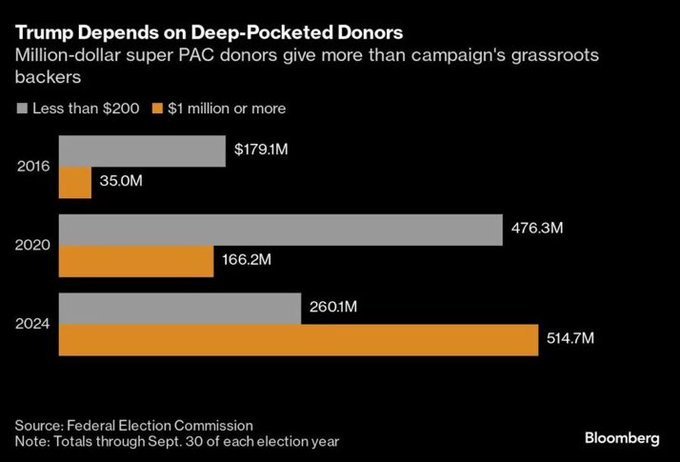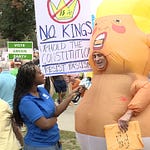
Election Day is upon us, and as you surely know, the presidential contest between Kamala Harris and Donald Trump is looking excruciatingly close. After Harris jumped to a small lead once she became the Democratic standard-bearer, Trump has tightened things up, primarily with the assistance of crazed former Democrat Robert Kennedy Junior.
How much support each candidate is receiving is truly difficult to say. Normally, public opinion surveys could provide some useful information in this regard but with pretty much every pollster showing the race within their studies’ sampling margins of error, the polls cannot be a reliable guide, especially since many of them seem to be engaging in “herding,” i.e. modifying their results to be similar to previous surveys.
With Trump and Harris each getting about 48 percent of the vote, the winner is going to be determined by how many of each candidate’s solid supporters actually turn in their ballots and also by what people who currently say they are undecided end up doing. Oftentimes, these undecided people end up not voting at all or leaving the presidential line blank.
Given Trump’s historically tyrannical, corrupt, and incompetent leadership, this race should not be a close one. It is nonetheless. And yet, despite some significant advantages that Trump has on the economy and the approval rating of President Joe Biden, it is my belief that Harris is poised to win a small victory tomorrow.
The primary reason I believe this is that Donald Trump is facing the classic celebrity problem: He’s overexposed.
After dominating the political landscape for nearly a decade, Donald Trump seems to be losing his grip on some Americans’ minds. At long last, Trump’s never-ending stream of corruption scandals, his non-stop offensive remarks, his ever-expanding retinue of controversial advisers, and his constant grifting have made some of his fans tired of it all.
As it has since the beginning of his political career, Trump’s strategy hinges on mobilizing his core supporters. However, the size of his base is not sufficient to secure victory. Realizing this, Trump has focused on attracting low-propensity voters who agree with him on certain issues but lack strong enthusiasm for his candidacy.
But the disgraced ex-president is likely drawing on a depleting well. That’s because Trump’s strategy this year is the exact same one that he employed in 2020. While it wasn’t sufficient to get him the victory against Joe Biden, Trump was remarkably successful. After receiving 63 million votes in 2016, Trump juiced his total to 74 million in his re-election bid.
But is it possible that Trump reached his ceiling in 2020? We can’t know at this juncture, but it’s possible that he may not have any more “unlikely voters” aside from young adults who have never voted before. The biggest indicator that his might be true is that Trump’s small-dollar donations are significantly lower than they were in 2020. As the Associated Press and Bloomberg reported last month, Trump has raised $260 million in donations of less than $200 each this year compared to $476 million in 2020. After nearly a decade of spamming his followers with endless (and even fraudulent) money requests, Donald Trump may have bled MAGA dry financially.
We’ll know soon whether the decrease in donations correlates to Trump receiving fewer votes, but one indication that it might is that Democratic enthusiasm to vote has been consistently higher since Kamala Harris entered the presidential race. According to Gallup, in March of 2024, 57 percent of registered Democratic and Democratic-leaning voters said they were “more enthusiastic than usual” about casting a ballot this year. That jumped to 79 percent in August after Harris jumped in and was at 77 percent in a late October survey, a number even higher than the previous record for Democrats set during the groundbreaking candidacy of Barack Obama in 2008. Republicans, meanwhile are stuck at 67 percent.
There might be millions of hidden Trump voters out there who have not been brought into the fold, but if you were to judge by the final campaign rallies he’s holding, the crowds are not indicating this either. Reporters have been filling up social media with video footage showing that the disgraced ex-president is no longer able to pack an arena in swing states, and that many of his supporters are leaving well before the programs are over.
While hardcore Republicans agree with the reactionary policies that Trump is promising to enact and pushed through during his single term, his appeal to nonpolitical people is based on his showmanship. He knows how to improvise, he can be funny, and he sometimes say truths that other Republicans are afraid to admit because he doesn’t fully buy into their ideology.
But after 9 years, the Trump show has gotten old. He never plays anything new and yet the act keeps getting longer and more boring. If you’ve seen one Trump rally, you’ve seen them all. At this point, attending one is more about meeting with friends than to hear the old guy yack for hours about nothing.
Aside from activating potentially sympathetic citizens, the other major ways that campaigns can pick up more votes are to reconcile with former supporters or persuade new ones. And as he makes his third run for the White House, Trump is trying to reconcile with his former supporters—without really changing anything at all about his larger policies, platform, or persona.
While he does seem to have picked off some conspiracy-loving Democrats by teaming up with Robert Kennedy and former Democratic Rep. Tulsi Gabbard, Trump has not been willing to cast aside his mostly unpopular policy positions like repealing the Affordable Care Act or executing drug dealers. He has also refused to rescind his blatant lies about the 2020 election or even apologize for trying to overturn the congressional certification and doing nothing as his supporters raided the U.S. Capitol. Instead of tamping down on his dictatorial rhetoric, Trump has only increased it, saying recently that he “shouldn’t have left” the presidency and that he wanted to execute former general Mark Milley.
Instead of dropping his unpopular stances, Trump has resorted to smaller gimmick proposals like ending federal income taxes on service tips and wild-eyed claims that he will magically replace income taxes with tariffs. These aren’t likely to win him new voters, especially since Trump has added new controversial stances like letting Israeli prime minister Benjamin Netanyahu “do what you have to do” in Gaza and also encouraging him to bomb Iran, even though it could set off a massive regional conflict.
Let’s go back to those former Trump voters for a second though.
Although Trump got more votes numerically in his second presidential bid, millions of the people who had supported him in 2016 declined to do so in 2020. That’s a sizable group of potential votes he could get in 2024.
There are multiple ways to slice this demographic, but the biggest group he lost support among in 2020 was among White men. (He lost a smaller amount among White women, stayed the same among Black voters, and gained significantly among Latinos, according to an internal Trump campaign memorandum.)
We don’t know how Trump will do among different demographic groups this time. This is largely because most public opinion surveys do not have sufficiently large enough sample sizes of smaller minority groups to be statistically meaningful. Given the continuing rapid growth of Hispanic evangelicalism, he is likely to pick up more support among Hispanics. Among Black voters, indications are unclear, especially since Black Americans who disagree with Democrats are less likely to vote. This is also true of the younger White men that Trump is trying to entice by appearing on the podcasts of bro-conservatives like Joe Rogan.
Trump has inadvertently made his task even more difficult since he keeps sending conflicting messages about early and mail-in voting. He frequently tells rally attendees to vote early, but then also derides methods of doing so as “stupid” and “terrible.”
“It’s sad when you have to go months early, it’s crazy,” Trump said in June. “What are they doing with all these votes?”
If you ask me, it doesn’t make a lot of sense to bet your entire campaign on getting low-propensity voters to show up on one particular day for a guy who they don’t even like that much. But that does appear to be what Trump is doing.
The fact that he has almost completely outsourced his get-out-the-vote operation to the political neophyte Elon Musk does not helping his situation either. Late-deciding voters often will make their decision at the very last minute, but as of now, in the gold-standard New York Times/Siena College poll, swing-state residents who settled on their vote choice just recently were breaking significantly for Harris, 55 percent to 44 percent. That echoes a public claim made by Harris campaign manager David Plouffe who wrote on Twitter/X last week that late-deciding voters are “breaking by double digits” for the vice president, with “the remaining undecideds looking more friendly” to them than Donald Trump.
Given all of the above, I think it’s fair to say that Harris has a slight edge going into Election Day tomorrow, despite some larger traditional metrics that Trump has in his favor.
I could be wrong though so please make sure you get out the vote, especially if you are in a swing state!















